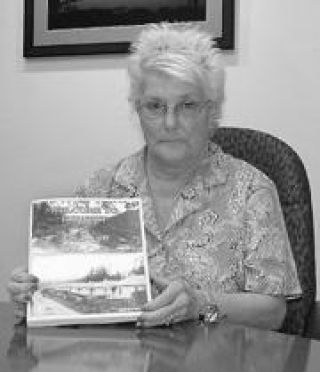By Shawn Skager
The Courier-Herald
For 10 years Cindy Calton lived in the past.
A longtime Plateau resident, including 11 years living in Lower Burnett, Calton spent up to 15 hours a day working on her book “Welcome to Burnett,” pouring over old issues of the Buckley News Banner chronicling the life and times of the now defunct town of Lower Burnett and the people who lived there.
“It took me 10 years to hand write it out,” she said. “I copied it from the Buckley News Banner, but they were so brittle I couldn't copy them.
“It was like an obsession with me,” Calton added. “I'd find an article and have to write it out. I didn't want to miss anything.”
Now the fruits of her labor are bound in a tome that tells the story of the coal company town and the people who inhabited it.
Nestled in a small valley east of present day South Prairie, the community of Lower Burnett came into being in 1880 courtesy of the rich veins of coal discovered in the surrounding hills.
“It was a company town, named after Charles Burnett, the coal mine supervisor,” Calton said. “It was around from 1880 to 1927, but was most populated from 1921 to 1926.”
According to Calton, a Buckley librarian, the town once numbered in excess of 600 people and included a school, post office, more than 60 houses and company stores.
“It was owned by the Pacific Coast Coal Company and you had to buy from the company, rent from the company,” she said. “Even your doctor bill, if you were hurt in the mines, they took it out of your pay.”
To illustrate the lives of the people who lived in Lower Burnett, Calton turned to the Buckley News Banner newspaper, published from 1891 to 1965.
The paper's archives, stored at the Foothills Historical Museum in Buckley, illustrate the social lives of the residents.
“From the beginning to end it goes in a storyline,” Calton said of her book. “It's interesting how populated and how busy it (Lower Burnett) was.”
“It had its wild times,” she added. “When the miners got off work, they liked to go to the saloons.”
Built on the strength of selling coal to the Tacoma School District, steamship lines and the railroads, as well as to San Francisco, the company town thrived until the early 1920s.
“They had a good thing going for almost 50 years,” Calton said.
Strikes in 1921 began the downward spiral of Lower Burnett.
“Coal became not as popular and it was too expensive,” Calton said. “They had to pump the ground water out of the mines constantly.”
The company ended up closing the town in 1927. According to Calton, the company demolished many of its stores and moved houses from the valley to nearby Carbonado, also a Pacific Coast Coal Company town.
A drive down Lower Burnett Road still provides some evidence to what was once there, Calton said.
“There is a big safe from the company store there on the left hand side,” she said.
Also remaining are foundations of the company's concrete storehouse for explosives and the sidewalk of the old school which burned down in 1929.
Now examples of the company houses can still be seen in Burnett, which sits on state Route 165.
Calton's book, which retails for $29.95, is available at the Foothills Museum, Chuck's Drug in Buckley and the Burnett Store.
“It speaks to certain people,” Calton said. “It's not a bestseller, but a lot of people who've bought it were either from there or their family grew up there.”
Calton's book is published by Heritage Quest Press.
Shawn Skager can be reached at sskager@courierherald.com.


